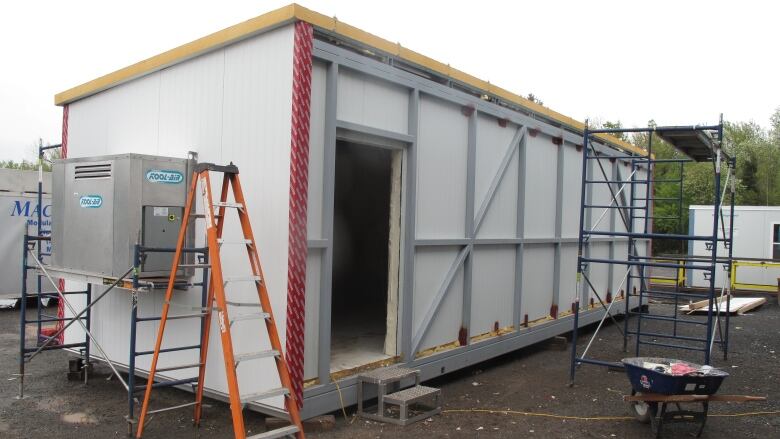High-tech, made-for-Nunavut community freezer on its way to Sanikiluaq
Solar-powered freezer designed for cold climate

Hunters inSanikiluaq, Nunavut, will soon have more storagefor seal, beluga and caribou meat thanks to a new community freezer on its way up this summer by sealift to the Belcher Islands.
The community's current freezer has been out of commission for years, rusting away.
"I don't think it's been used in the last 15 years," said Hudson Bay MLAAllan Rumbolt, who represents Sanikiluaq in the Nunavut legislature.
The community freezer is a staple in many Nunavut communities, providing a space for hunters to drop off their catch and share it with the rest of town, often free of charge.
"A lot of the times it gets put into the community freezer so that people who don't have access can at least get some meat," Rumbolt said.
Instead of a freezer, hunters in Sanikiluaq have turned to Facebook or local radio, advertising their catch to residents, then having them pick it up at their homes or along the shore.
This summer, the community will once again have an option of bringing it to one central place in an energy efficient, Nunavut-specific designed freezer unit, paid for by the territorial and federal government.

The unit has been designed to work in a colder climate by CanmetENERGY, a research and development organizationworking within Natural Resources Canada, who looked into a new system to replace outdated freezer technologies used throughout the territory.
"It's very important to design the machine to the local climate," said Daniel Gigure, an engineer with CanmetENERGY.
"If you design your refrigeration at the same condition as we design for a Montreal climate, for example, and you bring that technology to the North, you lose the benefit of the environment because of course the average temperature in the North is much lower."
The freezer unit is designed to reject heat at 15 C, instead of a standard 40 C, according to Gigure.
The units fit like air conditioners on a custom cold room designed by a Nova Scotia-based company. Once the cold room arrives in Sanikiluaqon a sealiftscheduled for later this month, solar panels will be installed on top to help provide someof the energy required to run the refrigeration system.
"We came up with a solution addressing the energy aspect, the reliability, the maintenance aspect and also taking the opportunity of the sun availability during the summer when the refrigeration load is at the maximum," said Chantal Leroy, a project manager with CanmetENERGY.
She said the freezer should be up and running by August.
Refrigeration technicians can be often hard to find in northern communities, so part of the developing process went into making a unit transportable by plane. In case it breaks down, a replacement unit can be flown in instead of waiting for someone to come fix it.
Leroy says she hopes thefreezer will becomea model for other Nunavut and northern communities.












_(720p).jpg)


 OFFICIAL HD MUSIC VIDEO.jpg)
.jpg)



























































































